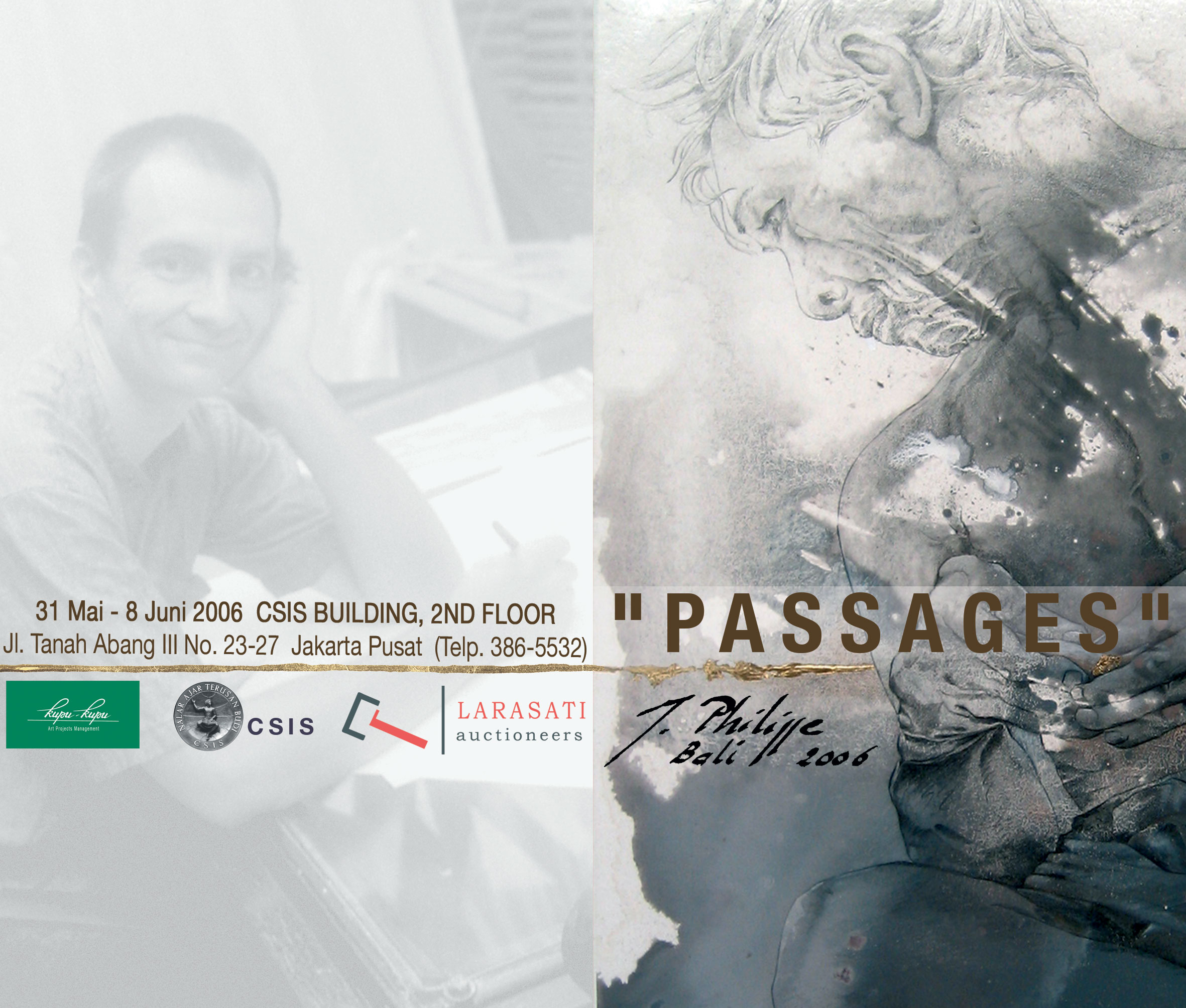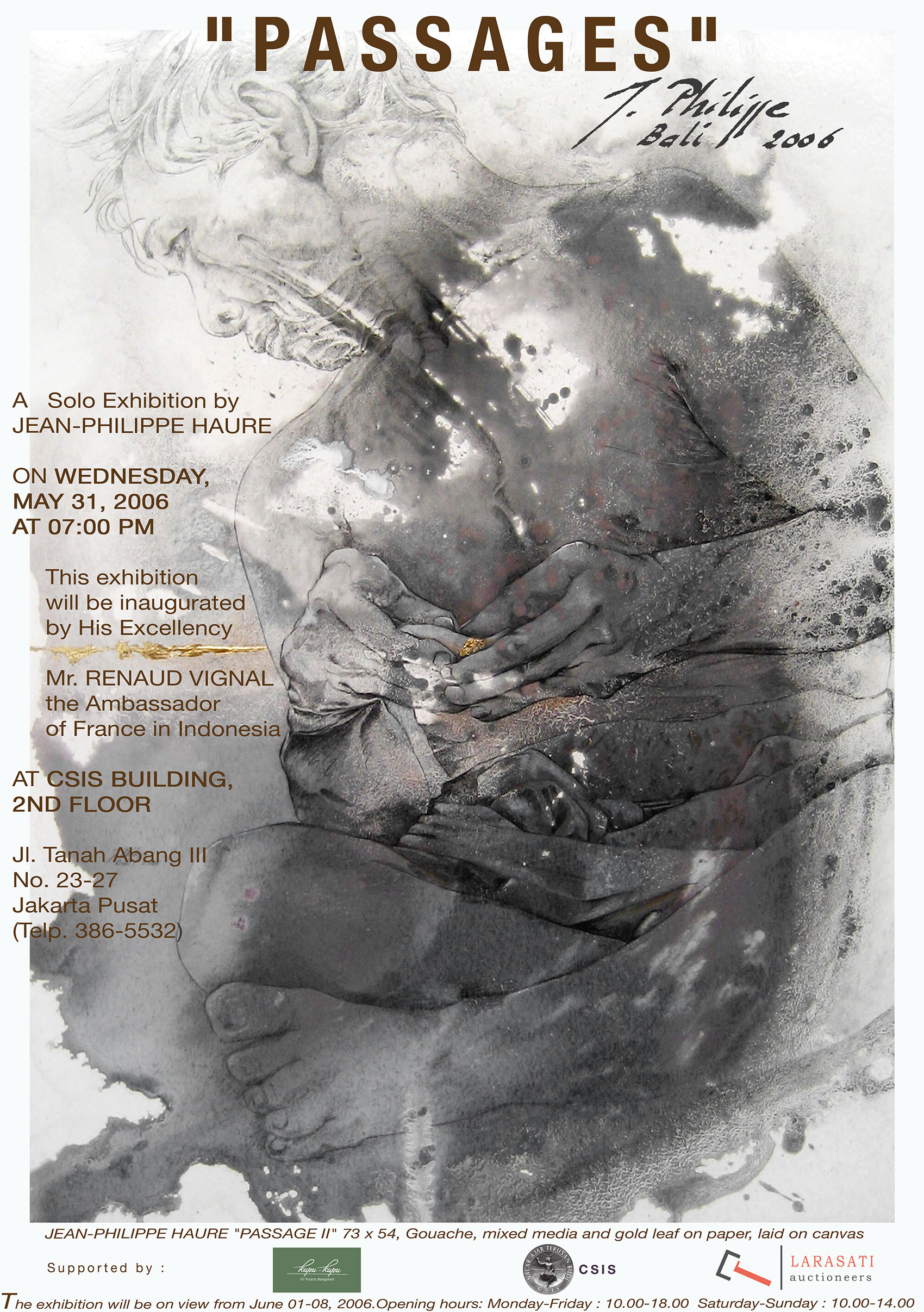The crossroads of abstraction and figuration, and of photography and painting.
J-Phillipe’s Balinese Window to a Brotherly Soul
By Jean Couteau [1]

The eye is first drawn to the soft-hued drippings of color spread over the paper surface. Blots appear here, a gravel-like texture there, vague shapes stand out and then melt away. An impression of calm and peace emanates from the work. It is "abstraction" at its best: a language of purely visual emotions expressed through what looks like a natural color world. Yet, as the eye rests longer on paper, another reading reveals itself, this time figurative: from behind the pastel wash colors appear the vague, yet finely drawn contours of a "classical" Balinese village scene, both hidden and revealed by the color surface. Our emotions, awakened by the abstract side of the work, are now guided toward the visual enjoyment of an idyllic land that happens to be Bali.
It is in the uncanny encounter – and balance between – the worlds of abstraction and figuration that J-Philippe finds the field of his inspiration.
This is no easy endeavour. One of the classic problems encountered by any painter is how to manage line and colour. Is he going to let color organize not only space and composition, by also the shaping of objects and characters, or will it follow a rhythm of forms determined by a graphic structure? Reciprocally, can the drawing line retain its autonomy of _expression when its space is “invaded” by color? How to achieve a balance? In J-PHILIPPE it is definitely color that structures the painting. The work is primarily abstract; its main pull is the color composition. The scenes superposed on the color surface always follow the basic rhythm of the latter. The drawing line is ever discreet, smoothly inserting the Bali theme into a pre-existing mood of the soul. But the intent is never descriptive. It is the mood of the soul that dominates the work. "If I don’t like the wash surface I have made," says J-PHILIPPE, "I just don’t carry on. I don’t draw anything. I leave the work unfinished."
Another classic issue artists face is that of "representation". What ought to be the part of the imaginary, of the spontaneous and of objective reality in an art work? If abstraction has its own, usually color-driven "logic", figuration calls in realistic and symbolic references. In this regard, what can be imitated, and what should be "invented"? What about the "realism" of a photograph? To which extent does it reveal "reality" – or the photographer’s "eye"? This question is of no small importance in J-PHILIPPE ’s case, as his drawings are based on photographs. Yet, there does not seem to be any problem. His photographs are of very high quality – as those exhibited with the paintings demonstrate. Their insertion as drawings enables the representation of scenes and physical attitudes that are un-thought of in ordinary figuration. Last but not least J-PHILIPPE does not strictly "duplicate" photographs, but rather "borrows" images from them. There is thus an enrichment of representation: in the photographs, what he shows is a "selected reality" that becomes an "invented figuration" in the paintings.
A "sensitive" answer to the problem of the encounter of genres, J-PHILIPPE’s paintings are exactly at the crossroads of abstraction and figuration, and of photography and painting.

What about the figurative content? Advocates of contemporary art will surely criticize the artist’s themes: "Bali. Exotic," they will say, without even looking closely at his works. And criticize it for being the post-colonial appropriation, by a foreigner, of a world ill-known to him. Yes, indeed, but isn’t there still beauty in Bali, which few artists reveal with as much talent as J-PHILIPPE? And why should an artist delve into the politics of contemporary art if his sensitivity takes him "outside" and makes him a “marginal” in the modern world. Doesn’t he have the right to find Balinese village life more coherent and balanced than modern life? Doesn’t he have the right, too, to ignore in his work the contradictions and ugliness of daily life and idealize the aesthetic and social cohesiveness still found in traditional Bali?
At a deeper level, J-PHILIPPE’s paintings are everything but exotic. Exoticism is basically a "misunderstanding". It underlines the outward differences of a culture, as if these differences represented its core, whereas they are simply details. With regard to Bali, exoticism hovers around ceremonies, offerings and the like, all that has contributed to the island’s paradise image. But this is not what interests J-PHILIPPE. The characters he represents in his works do not surprise us by their "otherness", but instead by the intimacy they emanate. What he sees in them are ordinary bodily gestures and a sense of togetherness. Innocent humans as we all should be. This perception of Bali as a land of innocence is very personal: J-PHILIPPE does not compel it on us, but instead reveals it, as if little by little, as the background of his color wash. The main quality of the artist here appears, beyond his style and technique: his sensitivity as a man of faith, open to other men and Humanity as a whole.
J-PHILIPPE is not your narcissistic kind of artist, obsessed by his own work and self. You may meet him many times, yet he will never talk about himself, and never even hint he is an "artist" with a "message". He will let you, or others, do all the talking, speak of "art", "expression", "concept" and whatever. But, unknown to all, back in his house in a field not far from the village of Mas, near Ubud, what will he do? He will enter his small lumbung (granary) workshop, shut himself inside, take a drawing pencil, open his computer and alone, launch himself into the world of his dreams, personal, intimate, sensitive, like the works soon to emerge under his hands.
Discretion and sensitivity is indeed the golden thread of J-PHILIPPE. He did not come from France to Indonesia through tourism – to "discover Bali"; nor did he come attracted by economic opportunities – to work. He came instead propelled by faith – to serve. Born to a Catholic family and a graduate of the reputed "Ėcole Boulle" – an art and craft school owned by the City of Paris– he came to Bali in 1991 as a faithful young Catholic lay brother, eager to develop a craft school set up in Gianyar by the Catholic community at the initiative of a French priest, Father Le Coutour. Once in Gianyar, and soon in Mas, he found in the village life around him a quiet atmosphere that suited his own meditative, highly religious soul. He saw in people around him brothers behaving like brothers, and living in a land where religion is still associated with community life and togetherness.
The great thing about an artist such J-PHILIPPE – straight, hardworking and discreet- is that it is almost certain that he will remain unfazed by fashion and that his future works, whatever their stylistic evolution, will continue having the stamp of sensitivity that is the man’s main quality.

Join the conversation